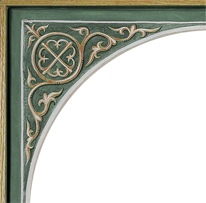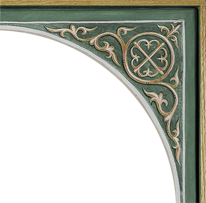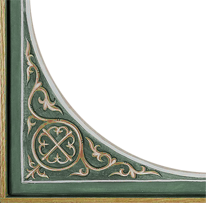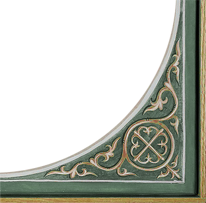The Divine Services Liturgy - 2
Last week we began our discussion and examination of the Divine Liturgy – the crown and glory of all the divine services which the Holy Church provides for us. We talked last time about the preparation that is fitting as we make ready to come before the Lord and His Mystical Supper. Today, we will begin speaking about the service of the Divine Liturgy itself… may God grant that our study of the liturgy brings us to a greater appreciation and fuller participation in this most holy and sacred of all the prayers of the Church.
The Divine Liturgy may be divided into three main parts: the Proskomedia – in which the elements to be used for the Mystery are prepared; the Liturgy of the Catechumens – in which the people attending are prepared for the Divine Mystery; and the Liturgy of the Faithful – in which the Mystery is celebrated and the faithful receive Holy Communion.
This first part of the liturgy, the Proskomedia, takes place within the holy altar – behind the closed doors and drawn curtain, somewhat obscure and unseen by the congregation, just as Christ’s early life was hidden from the masses. Within the altar there are two tables… the main altar table in the center of the altar and then, off to the left side, is the table of preparation or ‘prothesis’. It is at this side table where the first part of the liturgy takes place.
Having completed his entrance and vesting prayers and having washed his hands, the priest enters the holy altar and stands at the table of preparation. Before him are the diskos and the chalice (both empty at this time), vessels containing wine and water, the small hand spear which he will use to cut the bread, and the five breads (prosphora) which will be used as the holy offering. The Russian tradition uses five separate breads for the Proskomedia, the Greeks and some other Orthodox traditions use one or two large breads from which the portions are taken. My description here will follow the Russian tradition describing five separate breads, but the dedications and sequencing are the same for all traditions.
Taking the first prosphoron, the priest, with spear in hand, blesses it with the sign of the cross three times saying, ‘In remembrance of our Lord and God and Savior Jesus Christ.’ The prosphoron is stamped with a seal depicting a cross and the greek letters signifying Jesus Christ Conquers – IC XC NIKA. The priest then cuts out a cube of the size of the entire stamp, saying the words of the Prophet Isaiah, ‘He was led as a sheep to the slaughter. And as a blameless lamb before his shearers is dumb, so He openeth not His mouth. In His lowliness His judgment was taken away. And who shall declare His generation?’ This portion is called the Lamb and it represents Christ, of Whom the Paschal Lamb was the prototype. The priest then makes an incision in the form of a cross saying, ‘Sacrificed is the Lamb of God, that taketh away the sin of the world, for the life and salvation of the world.’ The Lamb is placed on the middle of the diskos and the priest pierces the side of the Lamb with the spear saying, ‘One of the soldiers with a spear pierced His side, and forthwith came there out blood and water. And he that saw it bare record, and his record is true.’ Wine and water are then poured into the chalice.
The second prosphoron is in honor of the Mother of God. The priest cuts out a triangular portion from the top of the bread saying, ‘In honor and remembrance of our most blessed Lady, the Theotokos and Ever-Virgin Mary, through whose intercessions do Thou, O Lord, receive this sacrifice upon Thy most heavenly altar.’ This particle is then placed on the diskos to the right of the Lamb saying, ‘At Thy right hand stood the queen, arrayed in a vesture of interwoven gold, adorned in varied colors.’
The third prosphoron is for the ‘nine ranks’ of the saints of God. From this prosphoron the priest cuts out nine small triangular portions in honor of St John the Forerunner and Baptist of the Lord, the prophets, the apostles, the hierarchs, the martyrs, the monastic saints, the unmercenaries, the saints commemorated on that day and the ancestors of God Joachim and Anna, and finally the saint whose liturgy is being celebrated (this is usually St John Chrysostom, but during Lent we commemorate St Basil the Great). These portions are placed on the diskos to the left of the Lamb in three rows.
From the fourth prosphoron portions are taken for the hierarchs, the priesthood, God-loving civil authorities, and all the living.
The fifth prosphoron is dedicated for those who have reposed.
Additionally, portions are taken from all the prosphora that are donated by the faithful and brought into the altar along with the names of their loved ones, both the living and the dead. These names are read and the priest cuts out particles from the prosphora to be placed on the diskos. When submitting our Commemoration Lists we should use the full Christian name of those being remembered (so ‘Anthony’ not ‘Tony’ and ‘Anastasia’ not ‘Stacey’, etc.). Clergy should be referred to by their rank: Archpriest Martin, Deacon George, not Fr Martin, Fr George. Also, be aware that, if you are submitting a commemoration slip to be used just for that day, then indicating someone as being ‘sick’ or as a ‘child’ is fine, but you might avoid such adjectives in your more permanent commemoration books. I have seen very ancient looking commemoration books indicating ‘child John’… and I suspect that John is probably a grandfather by now! And a final note… since these particles represent the members of the Holy Church, only those who are baptized Orthodox Christians should be commemorated in this way. In our private prayers we can and should pray for everyone… but liturgically we commemorate only those within the Body of the Orthodox faith.
At the end of the Proskomedia the priest covers the bread with a metal asterisk (star) and then covers the diskos and chalice with special veils, censes the diskos and the chalice and prays that the Lord bless the offered Gifts and remember those who have offered them and those for whom they are offered.
Assembled then, upon the diskos, is the Church of God, whose members consist of the Virgin Mary, the angels, all the holy men and women who have been pleasing to God, all the faithful Orthodox Christians, living and dead, and, in the center, its head, the Lord Himself, our Savior.
In this service of preparation and offering, it is tangibly evident how close and how loving is the community of the Orthodox Christian Church! Reading through the names of all of the families and loved ones of our parish, both the living and the dead, brings to the forefront the realization of that ‘Communion of Love’ to which we are called in Christ Jesus.
With the conclusion of the Proskomedia, the first part of the Divine Liturgy is completed and we are now ready to begin the Liturgy of the Catechumens. We’ll begin this portion in our next sermon.
May Christ our Lord, Who came to us with such a quiet and humble beginning as we see each time the Proskomedia is served, may He bless us and guide us all the days of our lives.
|




